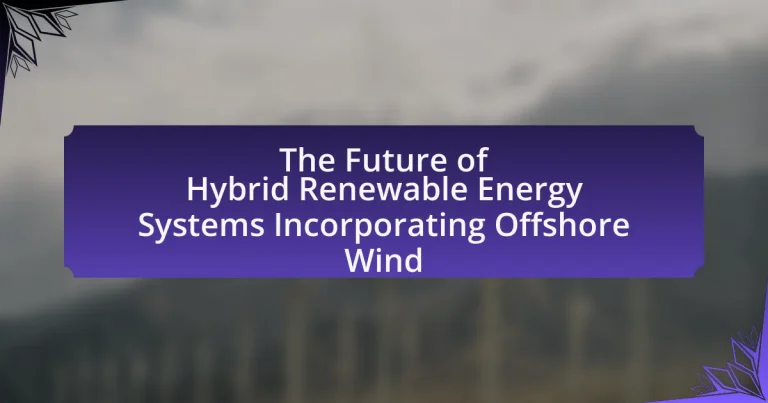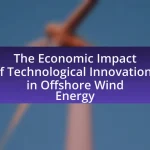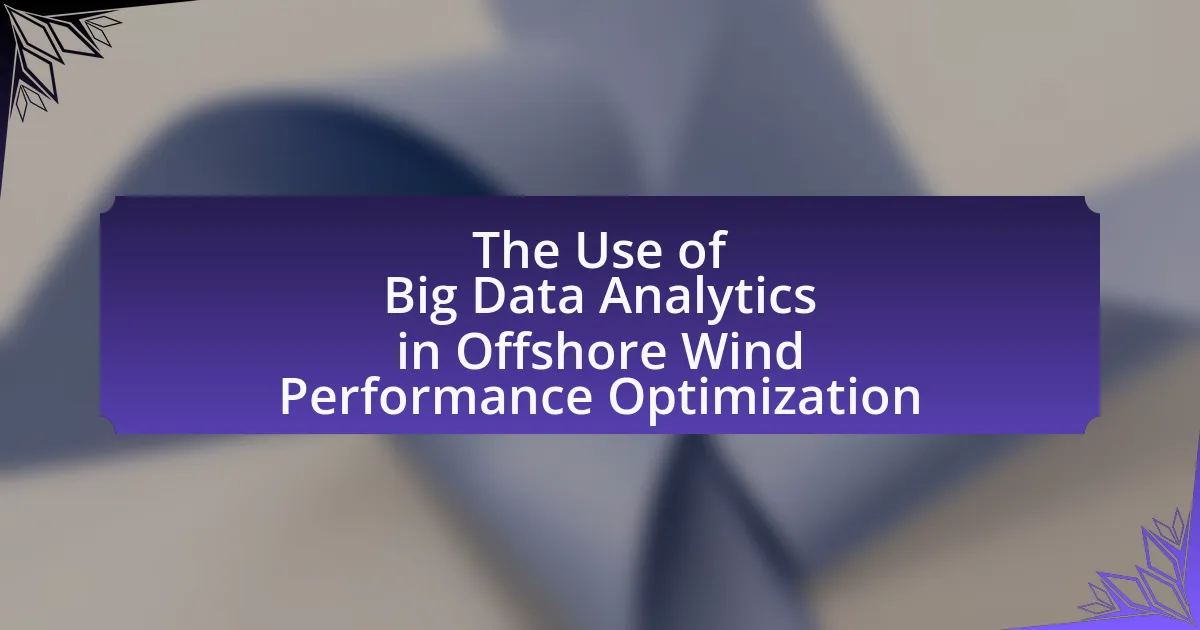Hybrid Renewable Energy Systems (HRES) represent a significant advancement in sustainable energy generation by integrating multiple renewable sources, including offshore wind, solar, and biomass. Offshore wind energy, characterized by its higher capacity factors and consistent wind speeds, enhances the reliability and efficiency of HRES, contributing to a more resilient energy grid. This article explores the functioning of HRES, the integration of offshore wind, current trends, technological innovations, regulatory considerations, and the challenges faced in their implementation. It also discusses the future prospects of hybrid systems, emphasizing the importance of public perception, stakeholder collaboration, and strategies for optimizing system performance.
What are Hybrid Renewable Energy Systems and Offshore Wind?
Hybrid Renewable Energy Systems (HRES) combine multiple renewable energy sources, such as solar, wind, and biomass, to optimize energy production and reliability. Offshore wind refers specifically to wind energy generated from turbines located in bodies of water, typically at sea, which harnesses stronger and more consistent wind speeds compared to onshore locations. The integration of offshore wind into HRES enhances energy output and stability, as offshore wind farms can provide significant power generation capacity, contributing to a more resilient and sustainable energy grid.
How do Hybrid Renewable Energy Systems function?
Hybrid Renewable Energy Systems function by integrating multiple renewable energy sources, such as solar, wind, and biomass, to optimize energy production and reliability. These systems utilize complementary generation profiles, where one source can compensate for the variability of another, ensuring a more stable and continuous energy supply. For instance, during periods of low sunlight, wind energy can provide the necessary power, while solar energy can be harnessed during sunny days, thus enhancing overall efficiency and reducing reliance on fossil fuels. Studies indicate that hybrid systems can achieve higher capacity factors and lower levelized costs of electricity compared to single-source systems, making them a viable solution for sustainable energy generation.
What components make up Hybrid Renewable Energy Systems?
Hybrid Renewable Energy Systems consist of multiple components, including renewable energy sources, energy storage systems, and power management systems. Renewable energy sources typically include solar panels, wind turbines, and sometimes biomass or hydroelectric systems, which work together to generate electricity. Energy storage systems, such as batteries or pumped hydro storage, are essential for balancing supply and demand, ensuring a reliable energy supply even when renewable sources are not producing energy. Power management systems integrate these components, optimizing energy flow and distribution to meet consumption needs efficiently. This combination enhances energy reliability and sustainability, making Hybrid Renewable Energy Systems a viable solution for future energy demands.
How does offshore wind integrate into these systems?
Offshore wind integrates into hybrid renewable energy systems by providing a consistent and substantial source of clean energy that complements other renewable sources, such as solar and hydroelectric power. The high capacity factors of offshore wind farms, often exceeding 40%, enable them to generate electricity even when other sources may be less productive, such as during cloudy or low-water periods. This integration enhances grid stability and reliability, as offshore wind can supply power during peak demand times, reducing reliance on fossil fuels. Furthermore, studies indicate that combining offshore wind with energy storage solutions can optimize energy dispatch and improve overall system efficiency, making these hybrid systems more resilient and capable of meeting future energy demands.
Why is the incorporation of offshore wind significant?
The incorporation of offshore wind is significant because it provides a substantial source of renewable energy that can help reduce greenhouse gas emissions and combat climate change. Offshore wind farms can generate electricity at a larger scale compared to onshore facilities due to stronger and more consistent wind speeds over the ocean. For instance, according to the Global Wind Energy Council, offshore wind capacity reached 35 gigawatts globally in 2020, demonstrating its growing role in the energy mix. This transition to offshore wind energy not only supports energy diversification but also contributes to energy security and economic growth through job creation in manufacturing, installation, and maintenance sectors.
What advantages does offshore wind provide in hybrid systems?
Offshore wind provides significant advantages in hybrid systems, primarily through enhanced energy generation capacity and reliability. The integration of offshore wind into hybrid systems allows for the harnessing of stronger and more consistent wind resources, which can lead to higher overall energy output compared to onshore wind. Additionally, offshore wind farms can operate in conjunction with other renewable sources, such as solar or tidal energy, to create a more stable and diversified energy supply. This diversification reduces reliance on any single energy source, thereby improving system resilience and efficiency. Furthermore, offshore wind installations typically have a lower visual impact and can be located away from populated areas, minimizing land-use conflicts. These factors collectively contribute to the effectiveness and sustainability of hybrid renewable energy systems.
How does offshore wind impact energy efficiency and reliability?
Offshore wind significantly enhances energy efficiency and reliability by providing a consistent and robust source of renewable energy. The high average wind speeds found offshore lead to increased energy generation compared to onshore wind farms, with studies indicating that offshore wind can produce up to 50% more energy due to less turbulence and more stable wind patterns. Additionally, offshore wind farms can operate at larger scales, allowing for greater energy output and improved grid stability. This reliability is crucial for integrating renewable energy into hybrid systems, as it helps balance supply and demand, reducing reliance on fossil fuels and enhancing overall energy security.
What are the current trends in Hybrid Renewable Energy Systems?
Current trends in Hybrid Renewable Energy Systems include the integration of offshore wind with solar and energy storage technologies, enhancing energy reliability and efficiency. This trend is driven by advancements in technology, such as floating wind turbines, which allow for deployment in deeper waters, and improved battery storage solutions that facilitate energy management. According to the International Renewable Energy Agency (IRENA), the global capacity of offshore wind energy is expected to reach 234 GW by 2030, indicating a significant shift towards hybrid systems that combine various renewable sources to optimize energy production and reduce carbon emissions.
How is technology evolving in the field of hybrid systems?
Technology in the field of hybrid systems is evolving through advancements in integration techniques, energy management systems, and the incorporation of artificial intelligence. These developments enhance the efficiency and reliability of hybrid renewable energy systems, particularly those that combine offshore wind with other energy sources. For instance, the integration of advanced energy management systems allows for real-time optimization of energy production and consumption, significantly improving overall system performance. Additionally, the use of artificial intelligence in predictive maintenance and operational optimization has been shown to reduce downtime and increase energy output, as evidenced by studies demonstrating up to a 20% increase in efficiency in hybrid systems utilizing AI-driven analytics.
What innovations are being introduced in offshore wind technology?
Innovations in offshore wind technology include larger turbine sizes, floating wind farms, and advanced energy storage systems. Larger turbines, such as those exceeding 12 MW, increase energy capture and efficiency, while floating wind farms enable deployment in deeper waters where wind resources are stronger and more consistent. Additionally, integrating advanced energy storage solutions, like lithium-ion batteries and pumped hydro storage, enhances grid stability and allows for better management of energy supply and demand. These advancements are supported by ongoing research and development efforts, including projects like the Hywind Scotland pilot, which demonstrates the viability of floating wind technology.
How do these innovations enhance system performance?
Innovations in hybrid renewable energy systems incorporating offshore wind enhance system performance by increasing energy efficiency and reliability. For instance, the integration of advanced energy storage technologies allows for better management of energy supply and demand, ensuring a consistent power output even during variable wind conditions. Additionally, the use of smart grid technologies facilitates real-time monitoring and optimization of energy distribution, reducing losses and improving overall system responsiveness. Studies have shown that these innovations can lead to a reduction in operational costs by up to 20% while increasing the capacity factor of offshore wind farms, thereby maximizing energy production and enhancing the sustainability of the energy system.
What are the regulatory and policy considerations for hybrid systems?
Regulatory and policy considerations for hybrid systems, particularly those incorporating offshore wind, include compliance with environmental regulations, grid integration standards, and investment incentives. These systems must adhere to national and local environmental laws, such as the National Environmental Policy Act in the United States, which mandates environmental assessments for new projects. Additionally, hybrid systems must meet grid interconnection requirements set by regulatory bodies like the Federal Energy Regulatory Commission, ensuring they can effectively integrate with existing energy infrastructure. Investment incentives, such as tax credits or grants, are also crucial for promoting the development of hybrid systems, as outlined in policies like the Investment Tax Credit for renewable energy projects. These considerations collectively shape the feasibility and implementation of hybrid renewable energy systems.
How do government policies affect the development of offshore wind?
Government policies significantly influence the development of offshore wind by establishing regulatory frameworks, providing financial incentives, and setting renewable energy targets. For instance, countries like the United Kingdom have implemented policies such as Contracts for Difference (CfD), which guarantee a fixed price for electricity generated from offshore wind, thereby attracting investment and reducing financial risk for developers. Additionally, the European Union’s Green Deal aims to increase offshore wind capacity to 300 GW by 2050, demonstrating how ambitious policy goals can drive technological advancements and infrastructure development in the sector. These policies create a conducive environment for growth, ensuring that offshore wind projects are economically viable and aligned with national energy strategies.
What incentives exist for integrating hybrid renewable energy systems?
Incentives for integrating hybrid renewable energy systems include financial subsidies, tax credits, and regulatory support. These incentives are designed to encourage investment in technologies that combine multiple renewable sources, such as wind and solar, to enhance energy reliability and efficiency. For instance, the Investment Tax Credit (ITC) in the United States allows for a significant percentage of the investment in renewable energy systems to be deducted from federal taxes, promoting the adoption of hybrid systems. Additionally, various governments offer grants and low-interest loans to support research and development in hybrid technologies, further incentivizing their integration into the energy grid.
What challenges do Hybrid Renewable Energy Systems face?
Hybrid Renewable Energy Systems face several challenges, including integration complexity, intermittency of energy sources, and high initial costs. Integration complexity arises from the need to coordinate multiple energy sources, such as solar, wind, and storage systems, which can complicate system design and operation. The intermittency of renewable sources like wind and solar can lead to reliability issues, necessitating advanced energy management systems to ensure a stable supply. High initial costs are often a barrier to deployment, as the investment required for infrastructure and technology can be significant. According to a report by the International Renewable Energy Agency, the upfront costs for hybrid systems can be 20-30% higher than traditional energy systems, which can deter investment despite long-term savings.
What are the technical challenges in integrating offshore wind?
The technical challenges in integrating offshore wind include grid connection, energy storage, and environmental impacts. Grid connection poses difficulties due to the distance from shore, requiring advanced infrastructure to transmit electricity efficiently. Energy storage is essential to manage the intermittent nature of wind energy, necessitating the development of reliable storage technologies. Environmental impacts must also be assessed, as offshore wind farms can affect marine ecosystems and navigation. These challenges highlight the complexity of integrating offshore wind into existing energy systems while ensuring reliability and sustainability.
How do grid compatibility issues affect hybrid systems?
Grid compatibility issues significantly hinder the efficiency and reliability of hybrid systems. These issues arise when the technical specifications and operational protocols of hybrid systems, which often combine renewable energy sources like offshore wind with traditional grid infrastructure, do not align with existing grid standards. For instance, discrepancies in voltage levels, frequency stability, and communication protocols can lead to increased operational costs, reduced energy output, and potential system failures. Studies indicate that addressing these compatibility challenges is crucial for optimizing the integration of hybrid systems into the grid, as evidenced by research from the International Renewable Energy Agency, which highlights that effective grid integration can enhance energy security and reduce reliance on fossil fuels.
What are the maintenance challenges associated with offshore wind?
Maintenance challenges associated with offshore wind include harsh environmental conditions, accessibility issues, and the complexity of turbine technology. The offshore environment exposes wind turbines to saltwater corrosion, extreme weather, and high waves, which can lead to increased wear and tear. Accessibility is a significant challenge, as maintenance crews often face difficulties reaching turbines due to rough seas and limited operational windows, resulting in higher costs and longer downtimes. Additionally, the sophisticated technology used in offshore wind turbines requires specialized knowledge and tools for repairs, complicating maintenance efforts. These factors collectively contribute to the overall maintenance challenges in offshore wind energy systems.
What economic challenges impact the future of hybrid systems?
The economic challenges impacting the future of hybrid systems include high initial capital costs, fluctuating energy prices, and the need for substantial investment in infrastructure. High initial capital costs can deter investment, as hybrid systems often require advanced technology and integration of multiple energy sources, which can exceed budget constraints. Fluctuating energy prices create uncertainty for investors and operators, making it difficult to predict returns on investment. Additionally, substantial investment in infrastructure is necessary to support the integration of offshore wind with other renewable sources, which can strain financial resources and require long-term commitments from stakeholders. These factors collectively hinder the widespread adoption and development of hybrid renewable energy systems.
How do initial investment costs influence system adoption?
Initial investment costs significantly influence system adoption by acting as a barrier or facilitator for stakeholders considering hybrid renewable energy systems. High upfront costs can deter potential adopters due to concerns about return on investment and financial risk, while lower initial costs can encourage adoption by making the technology more accessible. For instance, a study by the International Renewable Energy Agency (IRENA) found that reducing capital costs for offshore wind projects can lead to increased deployment rates, as stakeholders are more likely to invest when financial barriers are minimized. This correlation highlights the critical role that initial investment costs play in determining the pace and extent of system adoption in the renewable energy sector.
What role does market competition play in the hybrid energy sector?
Market competition drives innovation and efficiency in the hybrid energy sector. It encourages companies to develop advanced technologies and optimize their operations to reduce costs and improve service delivery. For instance, the increasing competition among renewable energy providers has led to significant reductions in the cost of solar and wind energy, with prices dropping by approximately 89% for solar and 70% for onshore wind between 2009 and 2019, according to the International Renewable Energy Agency. This competitive landscape not only enhances the viability of hybrid systems that integrate offshore wind but also accelerates the transition to cleaner energy sources, ultimately benefiting consumers through lower prices and improved energy options.
What are the future prospects for Hybrid Renewable Energy Systems incorporating Offshore Wind?
The future prospects for Hybrid Renewable Energy Systems incorporating Offshore Wind are highly promising, driven by technological advancements and increasing demand for sustainable energy solutions. These systems can enhance energy reliability and efficiency by integrating offshore wind with other renewable sources, such as solar and energy storage. According to the International Energy Agency, offshore wind capacity is expected to grow significantly, potentially reaching 234 GW by 2030, which supports the viability of hybrid systems. Additionally, the combination of offshore wind with other renewables can optimize energy generation, reduce costs, and facilitate grid stability, making them an attractive option for future energy infrastructure.
How might advancements in technology shape the future landscape?
Advancements in technology will significantly shape the future landscape of hybrid renewable energy systems, particularly those incorporating offshore wind. Innovations in turbine design, such as larger and more efficient blades, will enhance energy capture and reduce costs, making offshore wind more competitive with traditional energy sources. For instance, the deployment of floating wind farms allows for installation in deeper waters, expanding the potential for energy generation. According to the International Energy Agency, offshore wind capacity could reach 234 gigawatts by 2030, driven by technological improvements. Additionally, advancements in energy storage solutions, like lithium-ion batteries and emerging technologies such as solid-state batteries, will enable better integration of variable renewable energy sources, ensuring a stable energy supply. These developments collectively indicate that technology will play a crucial role in optimizing hybrid renewable energy systems and facilitating a transition to a more sustainable energy future.
What role will public perception and acceptance play in future developments?
Public perception and acceptance will significantly influence the future developments of hybrid renewable energy systems incorporating offshore wind. Positive public perception can lead to increased support for policy initiatives, funding, and community engagement, which are essential for the successful implementation of these technologies. For instance, studies have shown that communities with higher acceptance of renewable energy projects are more likely to experience smoother project development and fewer delays. According to a 2021 report by the International Renewable Energy Agency, public support is crucial for achieving the global renewable energy targets, as it directly impacts investment decisions and regulatory frameworks. Therefore, fostering a favorable public perception is vital for the advancement and sustainability of offshore wind energy initiatives.
What best practices should be followed for successful implementation?
Successful implementation of hybrid renewable energy systems incorporating offshore wind requires a comprehensive approach that includes stakeholder engagement, regulatory compliance, and technological integration. Engaging stakeholders early in the process ensures that diverse perspectives are considered, which can lead to smoother project execution and community support. Regulatory compliance is crucial, as adherence to local, national, and international regulations can prevent legal challenges and project delays. Furthermore, integrating advanced technologies, such as energy storage and smart grid systems, enhances the efficiency and reliability of energy production. These practices are supported by case studies showing that projects with strong stakeholder involvement and regulatory adherence have higher success rates, as evidenced by the successful deployment of offshore wind farms in Europe, which have demonstrated significant energy output and community acceptance.
How can stakeholders collaborate effectively in hybrid projects?
Stakeholders can collaborate effectively in hybrid projects by establishing clear communication channels and utilizing collaborative technologies. Effective communication ensures that all parties are aligned on project goals, timelines, and responsibilities, which is crucial in hybrid environments where teams may be distributed across different locations. Collaborative technologies, such as project management software and virtual meeting platforms, facilitate real-time information sharing and decision-making, enhancing coordination among stakeholders. Research indicates that projects with strong communication frameworks and the use of digital collaboration tools experience a 30% increase in efficiency and a 25% reduction in project delays, demonstrating the importance of these strategies in achieving successful outcomes in hybrid renewable energy systems.
What strategies can be employed to optimize system performance?
To optimize system performance in hybrid renewable energy systems incorporating offshore wind, strategies include enhancing energy management systems, improving predictive maintenance, and integrating advanced control algorithms. Energy management systems can optimize the dispatch of energy resources, ensuring that energy supply meets demand efficiently. Predictive maintenance utilizes data analytics to foresee equipment failures, reducing downtime and maintenance costs. Advanced control algorithms can dynamically adjust system operations based on real-time data, improving overall efficiency and reliability. These strategies collectively contribute to maximizing energy output and minimizing operational costs in hybrid systems.




